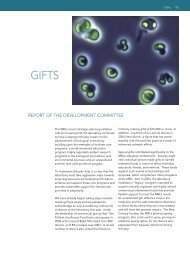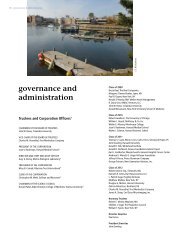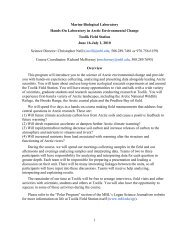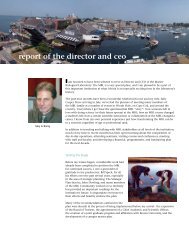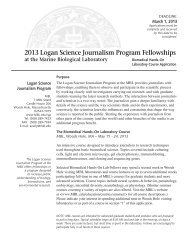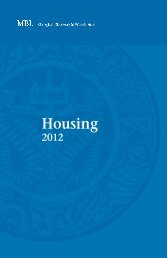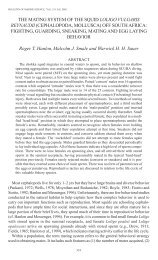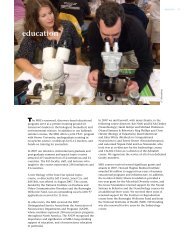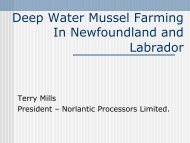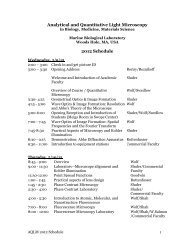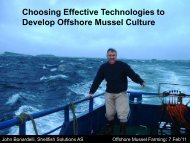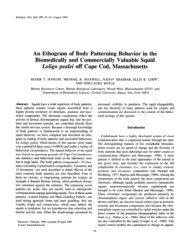PDF - Marine Biological Laboratory
PDF - Marine Biological Laboratory
PDF - Marine Biological Laboratory
You also want an ePaper? Increase the reach of your titles
YUMPU automatically turns print PDFs into web optimized ePapers that Google loves.
meeting Maurice Sussman, who was Sol<br />
Spiegelman’s graduate student. He was very<br />
intelligent, totally engrossed in research and we<br />
became inseparable. In 1948 I came back to the US<br />
to marry him. I also became Spiegelman’s graduate<br />
student.<br />
At that time, performing science with Sol was<br />
another unique experience. He was only a few years<br />
older than us, with not many more years of scientific<br />
experience, but talked as an old pro. He always had<br />
one problem dominating his mind and thought about<br />
it 18 hours a day. We had coffee breaks every 4<br />
hours to talk about experiments and we worked until<br />
11PM. The problem that he assigned to me was<br />
Saccharomyces chevalieri’s “long term adaptation”<br />
to galactose utilization(5). This strain of yeast<br />
required days of contact with galactose before the<br />
population became positive, in contrast with other<br />
strains of yeast that adapted in a few hours. I was<br />
supposed to find out its mechanism. Sol already had<br />
a working hypothesis that this strain had<br />
“plasmagenes” that controlled the synthesis of the<br />
new enzymes and he expected me to prove it. The<br />
first possibility was that a few cells in the growing<br />
population spontaneously mutated to gal + , followed<br />
by selection. I used the statistical analysis of Luria<br />
and Delbruck (6) to determine whether this was the<br />
mechanism. My results clearly showed that it was a<br />
massive population change requiring the continuous<br />
presence of galactose. At that time there were no<br />
available techniques to determine whether it was a<br />
cytoplasmic or a nuclear phenomenon. Nevertheless,<br />
Sol published my results as: “On the cytoplasmic<br />
nature of long term adaptation in yeast” (7). It took<br />
47 years to shed light on that phenomenon: a paper<br />
published in 1997 (8), showed the “two step model”<br />
of gal operon induction, involving three specific<br />
interacting proteins, necessary to start transcription<br />
of the gal promoter in the nucleus. Later Sol<br />
contributed significantly to science, always in a<br />
pioneering way, for example studying viruses that<br />
induce cancer. One example of his creative mind<br />
was demonstrating the in vitro evolution of an RNA<br />
virus (9).<br />
In 1950 I had my first son, Paul, and we moved<br />
to Evanston, Ill, because Maurice had accepted an<br />
appointment as Instructor and established a lab in<br />
the Biology Department at Northwestern University.<br />
Maurice wanted to apply the powerful approaches of<br />
the newly constituted discipline of Molecular<br />
Biology to phenomena of cell differentiation and<br />
morphogenesis that attend the genesis of<br />
multicellular organization. He chose to study the<br />
cellular slime molds, primitive amoebae that<br />
displayed two distinct and separate phases, namely,<br />
2<br />
growth and differentiation. He established controlled<br />
conditions to study their development in sufficient<br />
number and synchronously to be able to identify and<br />
study the kinetics and logistics of key biochemical<br />
events, particularly the synthesis of new proteins that<br />
attend differentiation into fruiting body (10).<br />
I wanted children, and although taking care of<br />
them has always been my first priority, I did not want<br />
to quit science completely in doing so. However, at<br />
that time, no lab would hire a woman with a child<br />
and able to work only part-time. So I started work in<br />
Maurice’s lab for 2 hours a day. Two more sons came<br />
along 3 and 4 years apart. Our income was very low<br />
and we could not afford baby sitters. Moreover,<br />
in those days, fathers did not participate in the daily<br />
care of the offspring. My mother came to my rescue,<br />
because she understood my passion for science so<br />
with the last two babies she left the family in Chile<br />
and came to help me for 8 months each trip. With her<br />
overseeing the children I was able to increase the<br />
hours I spent in the lab. The focus of Maurice’s<br />
research at that time was to isolate mutants that grow<br />
normally but have aberrant morphogenesis (11-14).<br />
In 1958 we moved to the Biology Department of<br />
Brandeis University in Waltham MA (with a<br />
professorship for Maurice but no academic<br />
appointment for me), where we found excellent<br />
graduate students and an exciting scientific<br />
atmosphere. The Chairman of Biochemistry, Nathan<br />
Kaplan, was a genius in recruiting young scientist<br />
with creative minds. He arranged to have our lab<br />
adjacent to the biochemistry labs. People that<br />
happened to meet in the hall started to talk about their<br />
latest scientific results, which led to open discussions.<br />
I would not have been able to learn the latest<br />
techniques in molecular biology and apply them to<br />
slime molds without the daily contact with Julius<br />
Marmur (15) who was so generous sharing the latest<br />
information, Larry Grossman (16), and Gordon Sato<br />
(17) among others. I continued to collaborate with the<br />
ongoing research in our lab, which had more students<br />
and post-docs (18 - 21), and was able to show that<br />
vegetative amoebae fused producing heterozygotes<br />
that segregated in a Mendelian fashion (22).<br />
In 1961, we took a sabbatical year to work at the<br />
Pasteur Institute in Paris. I chose to work with<br />
François Jacob and upon arrival told him that I was<br />
interested in studying repressors of lysogenic viruses.<br />
These bacterial viruses, upon infection, had a choice<br />
of either express most of its genes, thereby<br />
reproducing, lysing the host and producing clear<br />
plaques on the bacterial lawn, or to express only two<br />
genes – CI and CII - which repressed all the lytic<br />
genes and produced turbid plaques. At that time the<br />
repressors were inferred from clear plaque mutations<br />
Downloaded from<br />
www.jbc.org by on March 3, 2009



